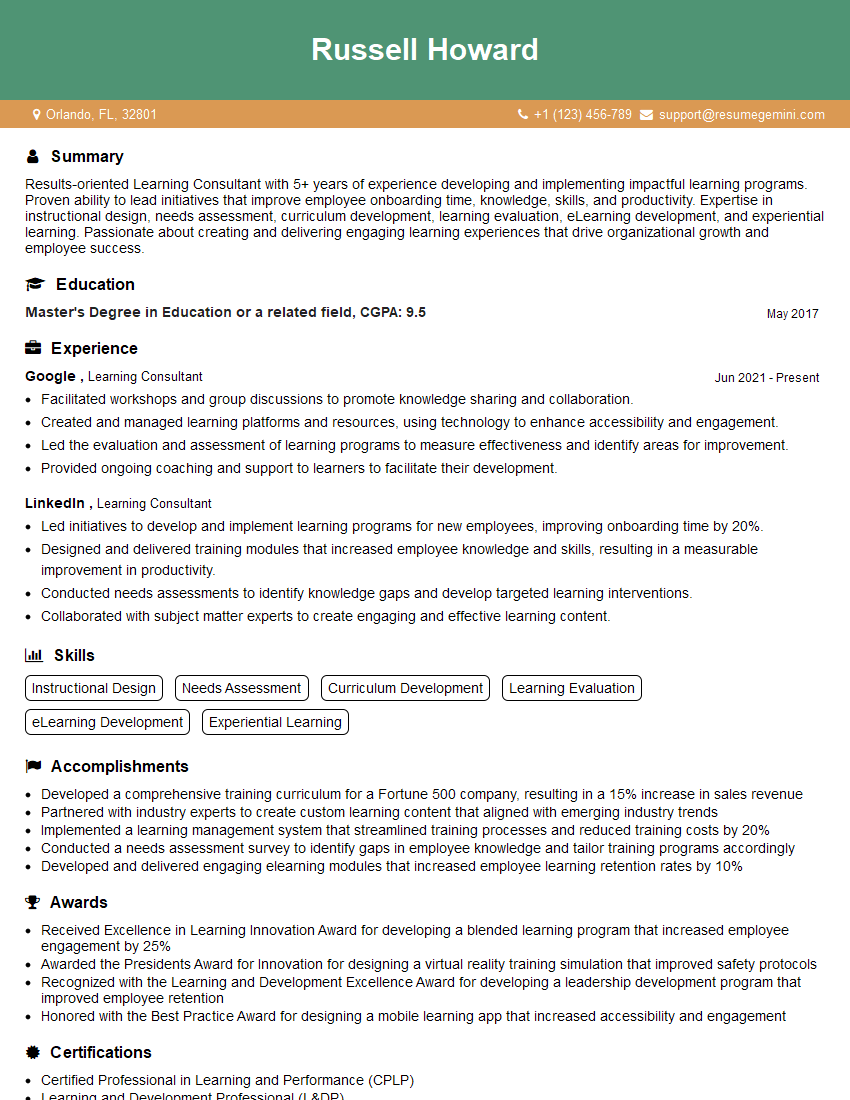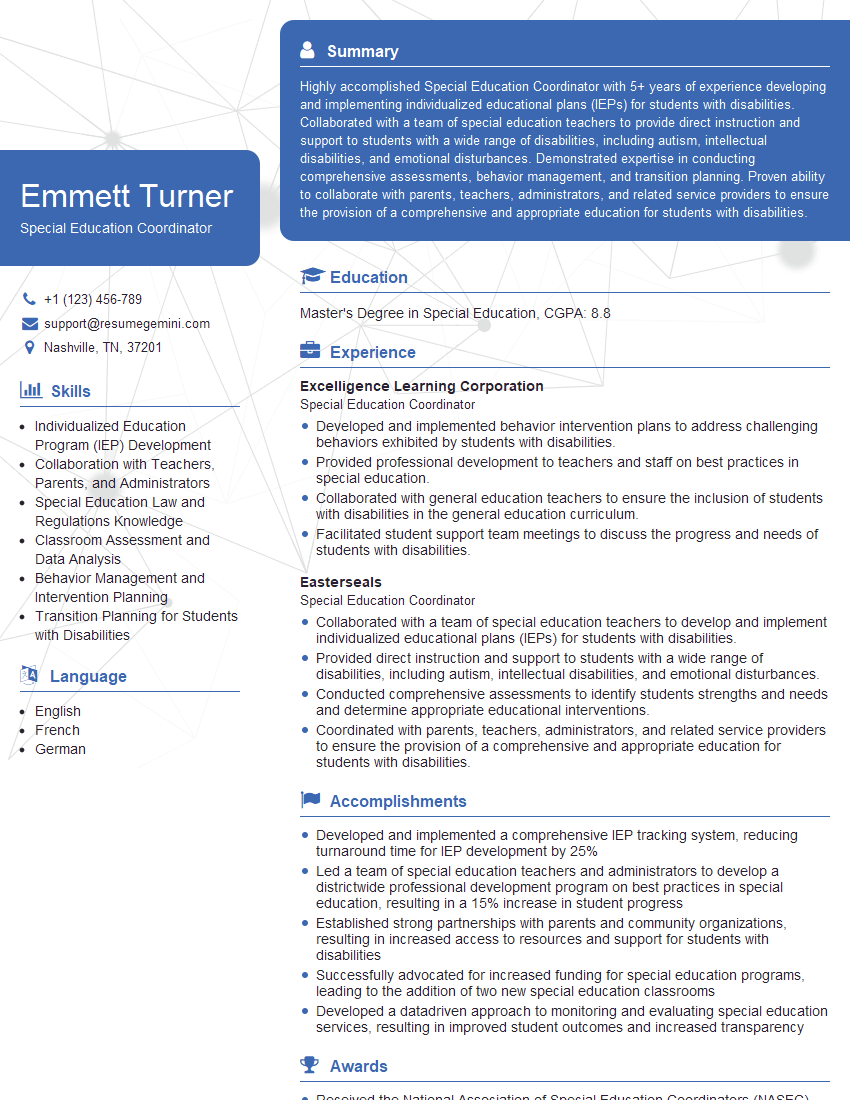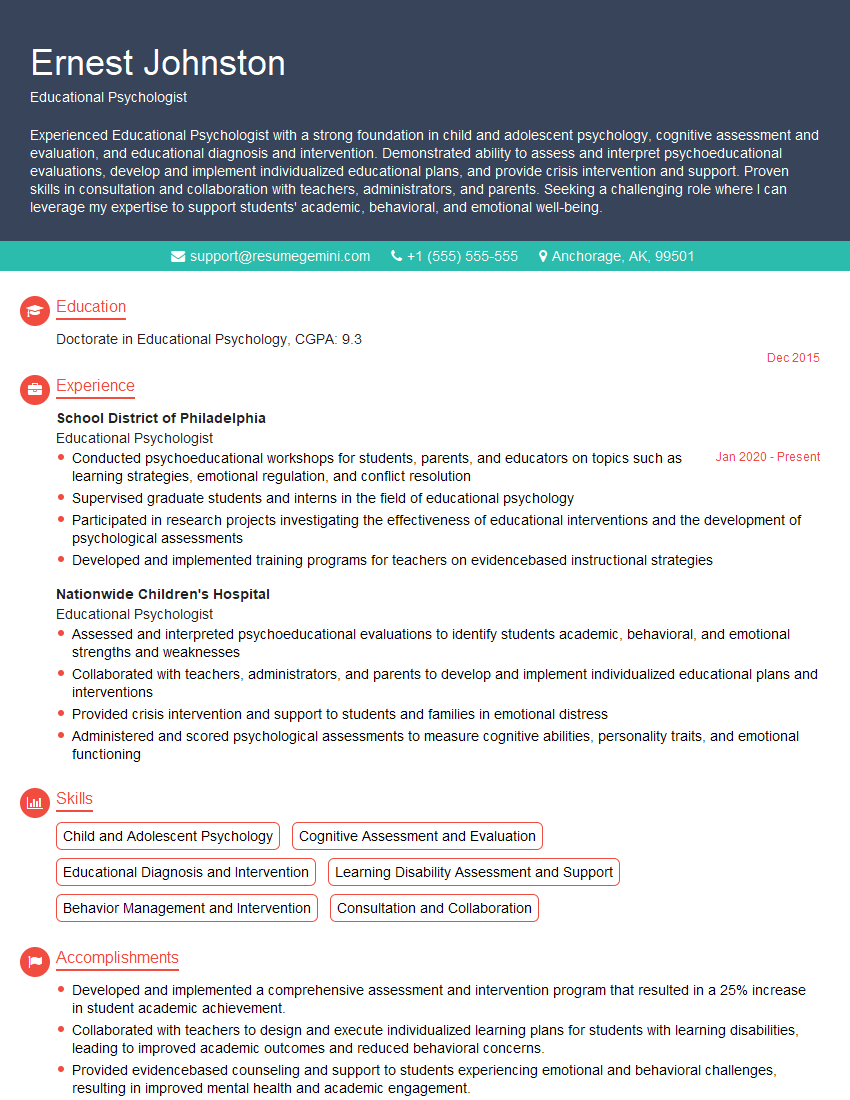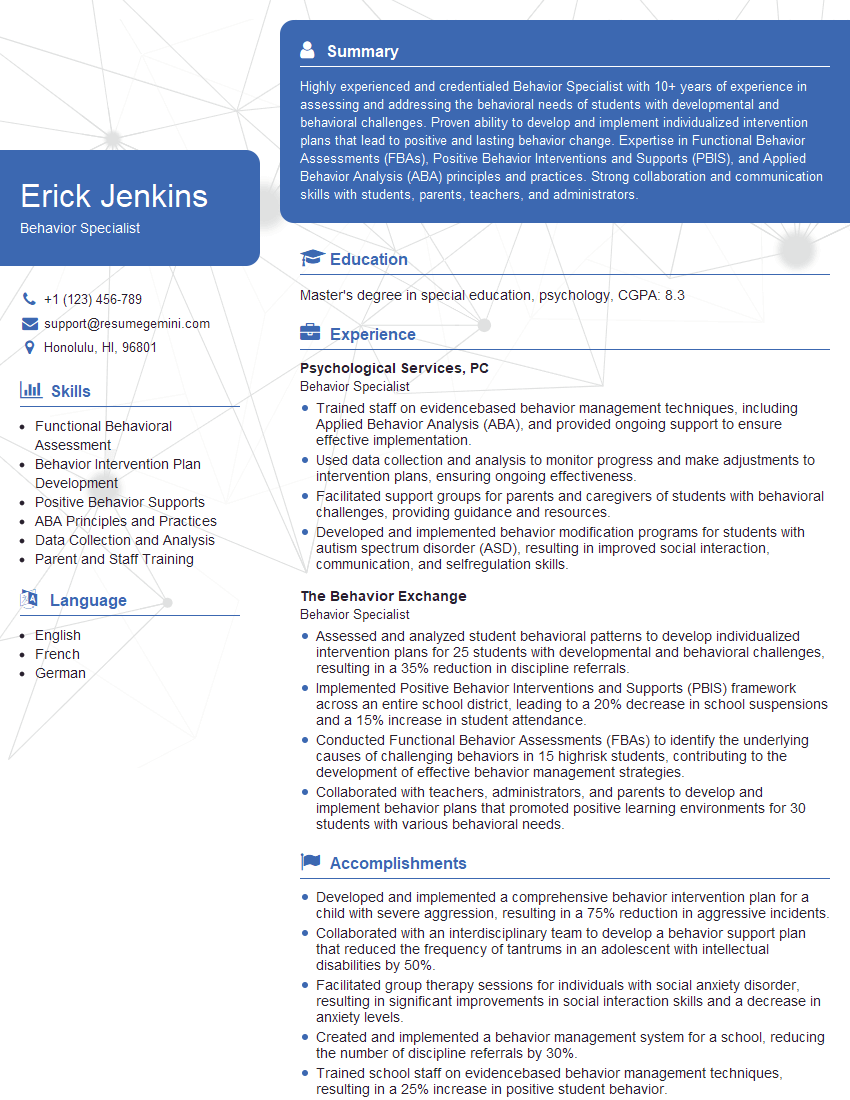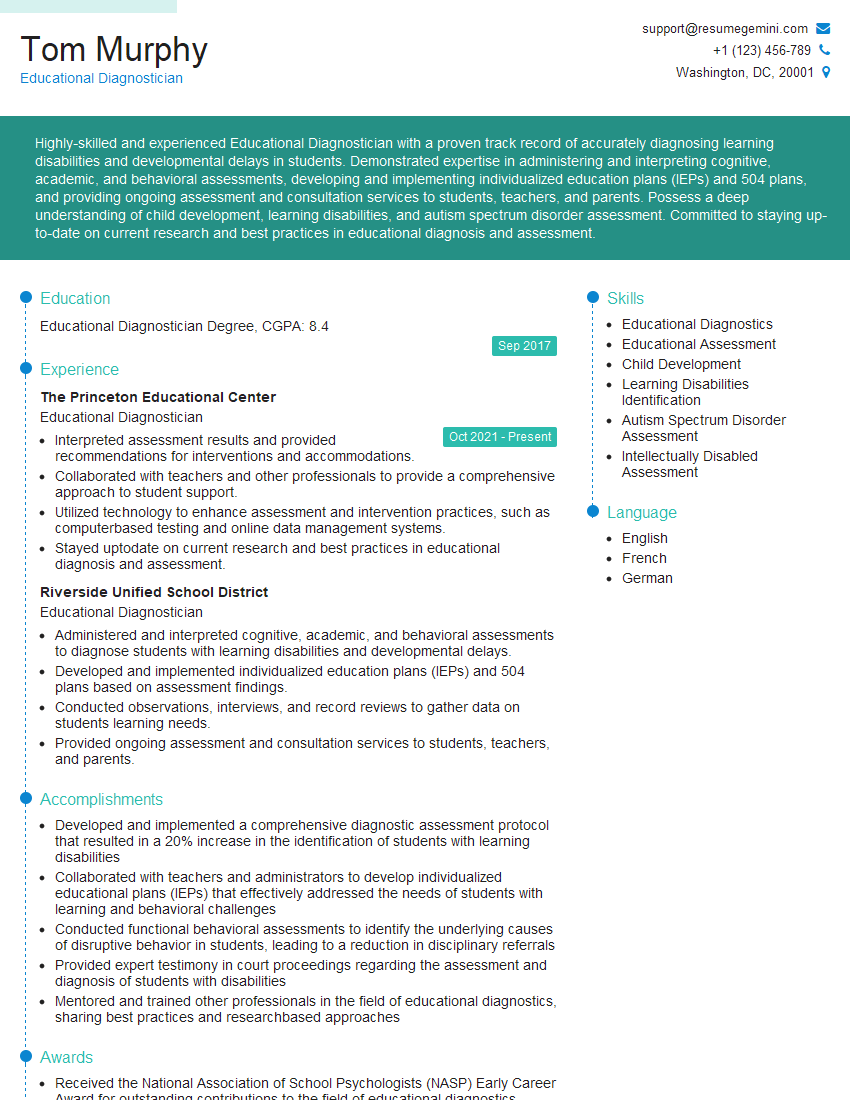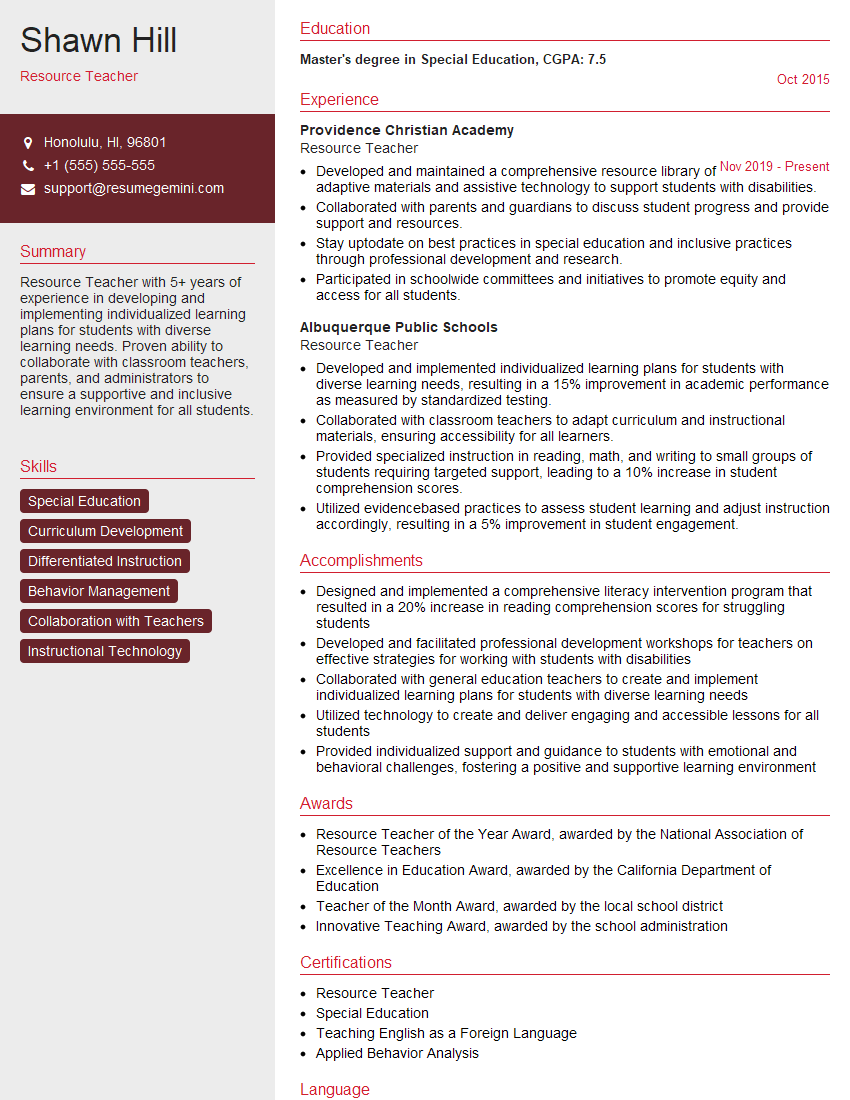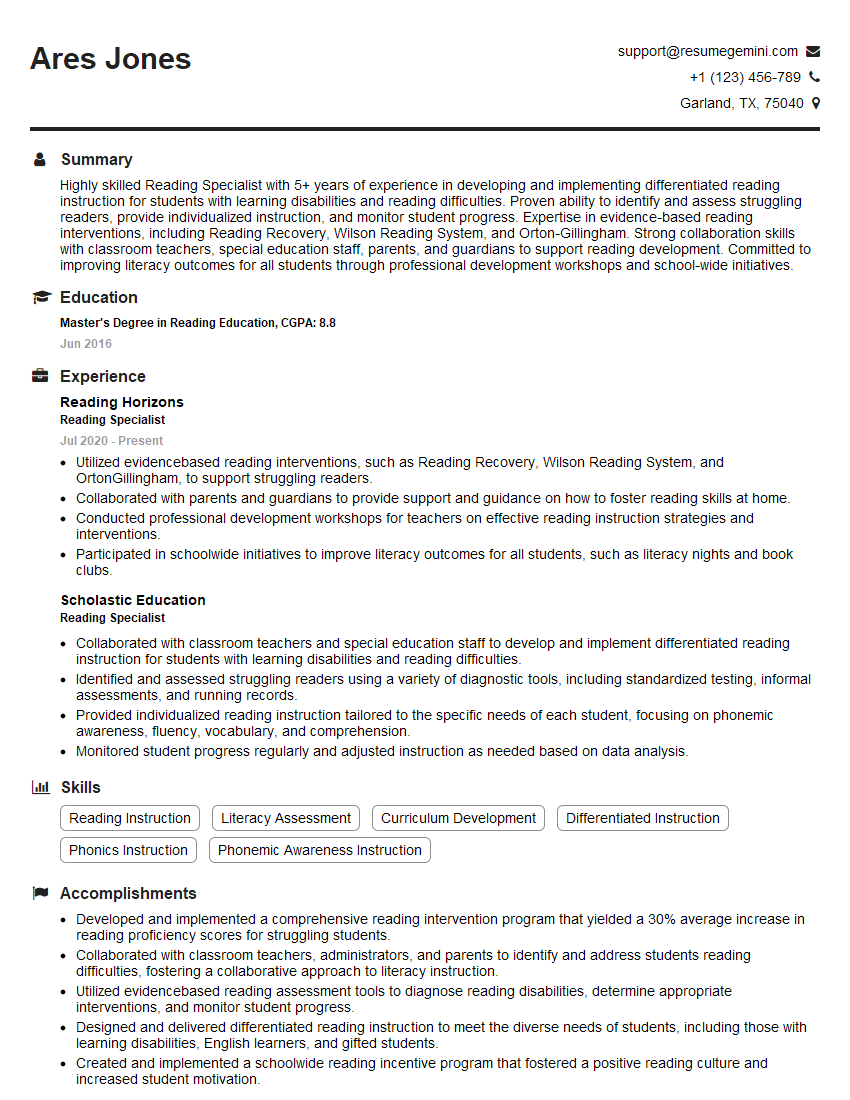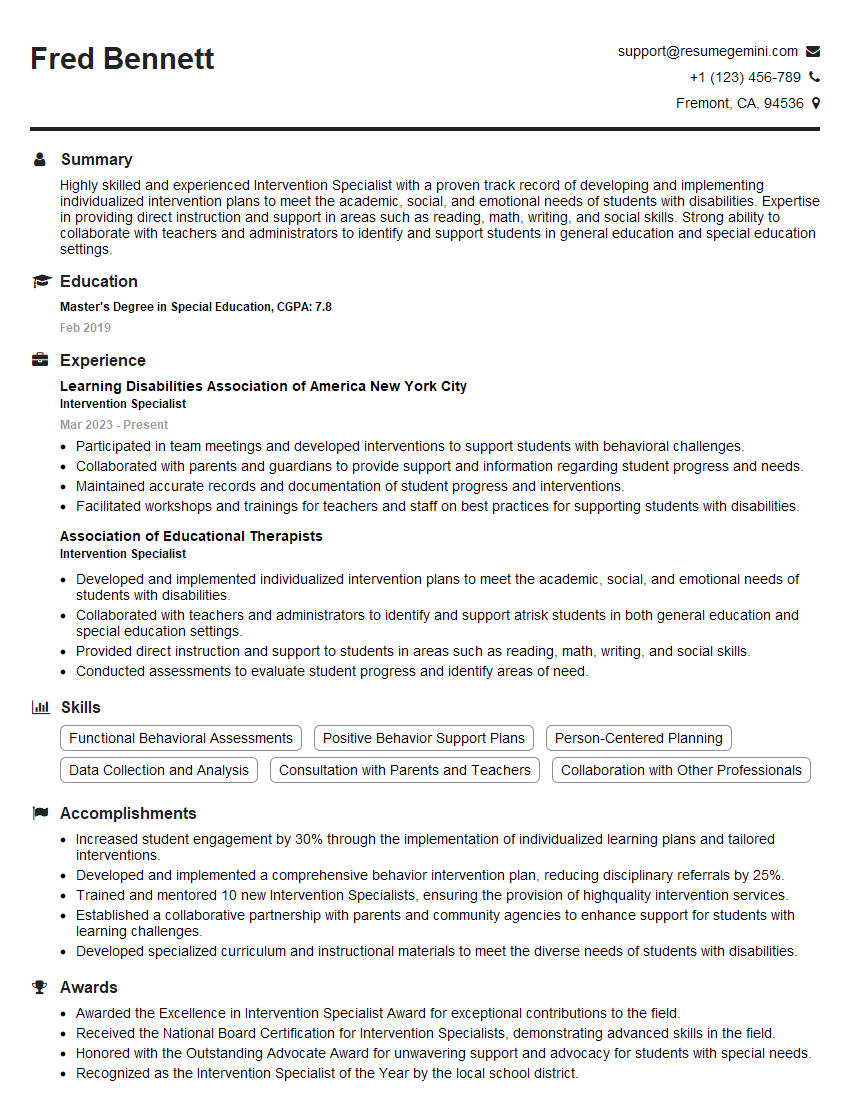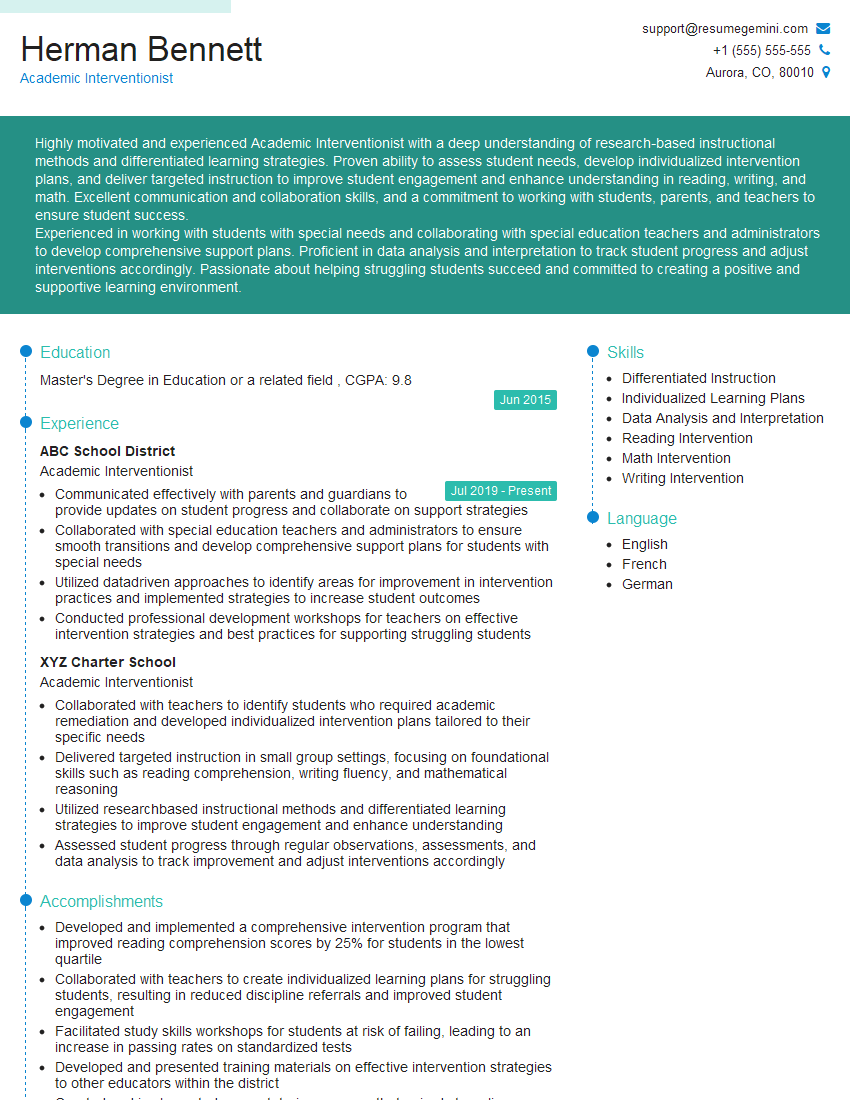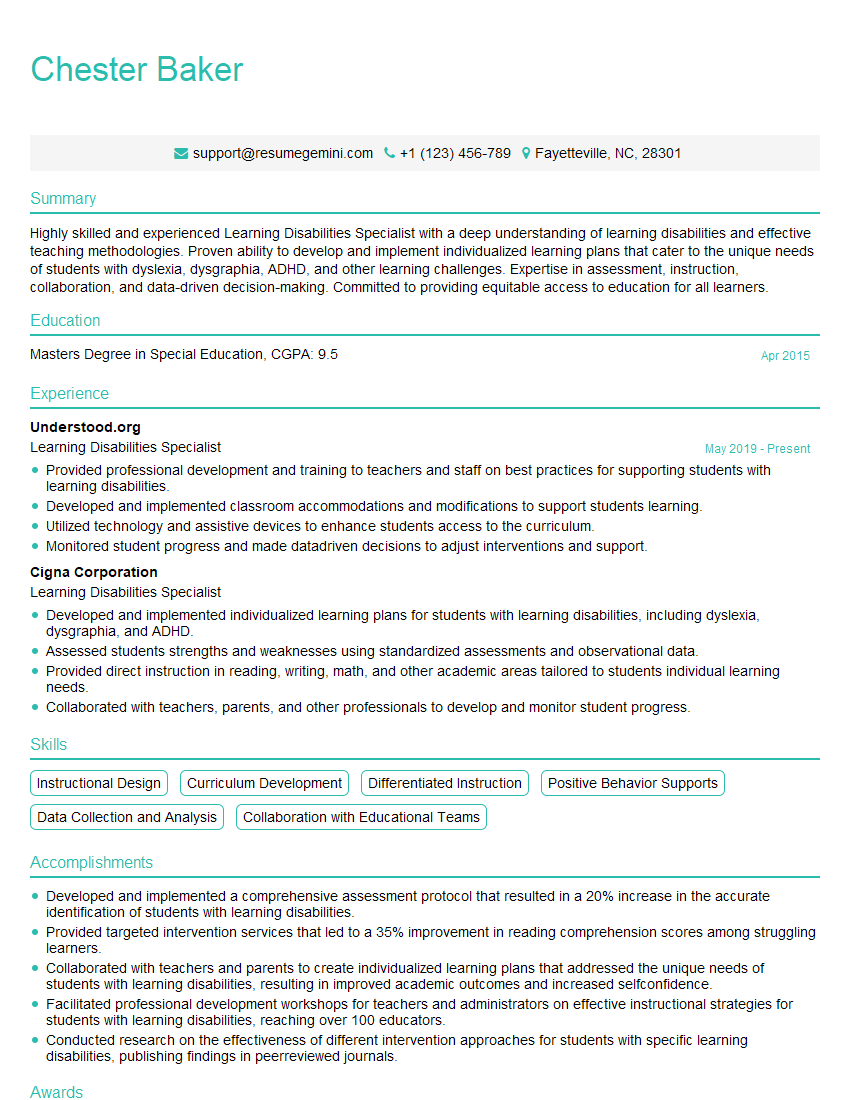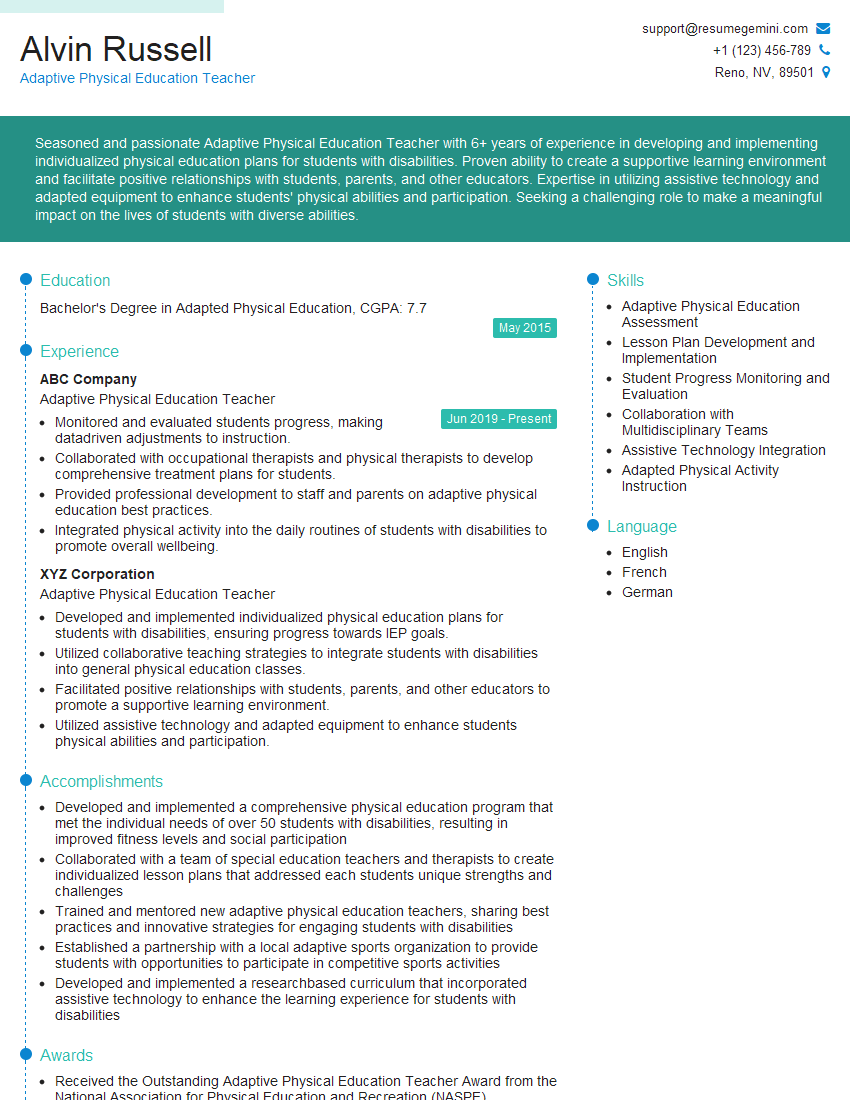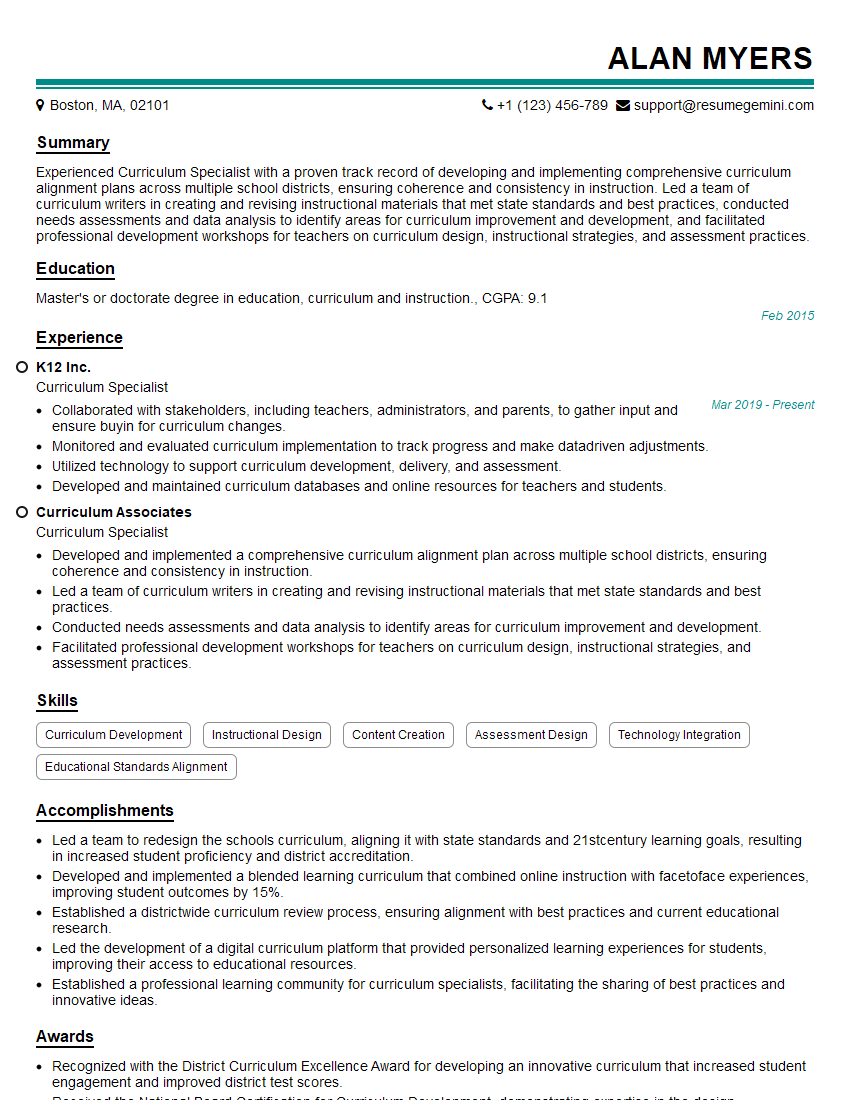The right preparation can turn an interview into an opportunity to showcase your expertise. This guide to Educational Diagnosis and Intervention interview questions is your ultimate resource, providing key insights and tips to help you ace your responses and stand out as a top candidate.
Questions Asked in Educational Diagnosis and Intervention Interview
Q 1. Describe your experience conducting comprehensive educational assessments.
Conducting comprehensive educational assessments involves a multifaceted approach designed to thoroughly understand a student’s learning strengths and weaknesses. This goes beyond simply administering a test; it’s about building a holistic picture of the student within their learning environment.
My process typically begins with a review of existing data – reports from previous teachers, medical records, and any previous assessments. Then, I use a variety of assessment methods, including standardized tests (like the Woodcock-Johnson or Wechsler scales), curriculum-based measurements (CBM), informal assessments (like observation in the classroom and work samples), and interviews with the student, teachers, and parents. This triangulation of data provides a richer understanding than any single measure alone could offer. For example, a student might score poorly on a standardized reading test but demonstrate strong comprehension during a classroom discussion, indicating a potential discrepancy between test-taking skills and actual reading ability. This comprehensive approach allows me to accurately pinpoint areas needing intervention and to understand the underlying reasons for academic difficulties.
Finally, I synthesize all the data to create a detailed report that offers concrete recommendations for instructional strategies and support services. The report is not just a list of deficits, but a roadmap for success, highlighting strengths and suggesting individualized approaches to learning.
Q 2. Explain the process of developing an Individualized Education Program (IEP).
Developing an Individualized Education Program (IEP) is a collaborative process involving educators, parents, and the student (when appropriate). It’s a legally binding document that outlines specific educational goals and services for students with disabilities who qualify under the Individuals with Disabilities Education Act (IDEA).
The process typically begins with a referral for an evaluation, which leads to the comprehensive assessment I described earlier. Once the assessment is complete and eligibility is determined, the IEP team meets to develop the IEP. This team includes the student’s parents, at least one regular education teacher, a special education teacher, a school administrator, and any other professionals relevant to the student’s needs (e.g., an occupational therapist, speech-language pathologist).
The IEP outlines specific, measurable, achievable, relevant, and time-bound (SMART) goals for the student. It also details the services and support the student will receive to help them achieve these goals. For example, a student with dyslexia might have goals related to phonemic awareness, decoding, and reading fluency. The IEP would specify the types of instruction, accommodations, and assistive technology that will be provided. The IEP is reviewed and revised regularly to ensure it continues to meet the student’s evolving needs.
I believe in fostering a collaborative, empowering environment during IEP meetings, ensuring parents feel heard and understood and are actively involved in shaping their child’s educational journey.
Q 3. What assessment tools are you proficient in using?
I am proficient in using a wide range of assessment tools, catering to diverse learning styles and needs. This includes standardized achievement tests such as the Woodcock-Johnson IV Tests of Achievement, the Wechsler Intelligence Scale for Children (WISC), and the Kaufman Test of Educational Achievement (KTEA). I also regularly use curriculum-based measurement (CBM) probes to monitor student progress in core subjects like reading and math. These are quick, efficient assessments that provide ongoing data for instructional decision-making.
Beyond standardized tests, I’m skilled in conducting informal assessments, such as observations in the classroom, analyzing student work samples, and conducting interviews with students and teachers. I’m also familiar with diagnostic tools for specific learning disabilities, like the Test of Phonological Awareness (TOPA) for dyslexia and the Connors Rating Scales for ADHD. My choice of assessment tools always depends on the specific questions being asked and the individual needs of the student.
Q 4. How do you differentiate instruction to meet the diverse learning needs of students?
Differentiated instruction is the cornerstone of effective teaching. It’s about adapting teaching methods, materials, and assessment to meet the diverse learning needs of all students within a classroom. This isn’t about lowering standards; it’s about providing the right support to help each student reach their full potential.
My approach involves understanding the diverse learning styles and needs of my students through ongoing assessment. I differentiate based on readiness (adjusting the complexity of tasks based on student ability), interest (providing choices in assignments to engage students’ passions), and learning profile (adapting the methods of instruction to cater to different learning styles – visual, auditory, kinesthetic). For example, for a lesson on fractions, I might provide visual aids for visual learners, verbal explanations for auditory learners, and hands-on activities using manipulatives for kinesthetic learners. I might also offer tiered assignments, where students choose a task that aligns with their readiness level.
Regular monitoring of student progress through formative assessments (like exit tickets or quick checks) allows me to make adjustments to my teaching approach as needed. This dynamic approach to instruction ensures that all students are challenged appropriately and have the support they need to succeed.
Q 5. How do you collaborate with parents and other professionals?
Collaboration is paramount in educational diagnosis and intervention. I believe in building strong, trusting relationships with parents and other professionals to create a supportive network for the student.
With parents, I prioritize open communication, providing regular updates on the student’s progress, explaining assessment results in an accessible way, and involving them in decision-making processes. I regularly use various communication methods, including emails, phone calls, and parent-teacher conferences. I find that involving parents in the process is essential for consistent support and buy-in.
Collaboration with other professionals, such as special education teachers, therapists (occupational, physical, speech-language), and school counselors, involves regular communication and joint planning. We share information, coordinate services, and ensure a cohesive approach to supporting the student’s needs. Team meetings, shared electronic documentation systems, and informal discussions allow us to keep everyone informed and working towards common goals. This collaborative approach leads to the most comprehensive and effective interventions for students.
Q 6. Describe your experience with various learning disabilities (e.g., dyslexia, ADHD).
I have extensive experience working with students with various learning disabilities, including dyslexia, ADHD, and others. Understanding the specific characteristics of each disability is crucial for effective intervention.
For students with dyslexia, my approach involves explicit and systematic instruction in phonological awareness, phonics, fluency, vocabulary, and comprehension. I use multi-sensory techniques and assistive technologies to support their learning. For instance, I might use colored overlays for reading materials or utilize text-to-speech software.
With students who have ADHD, strategies focus on organizational skills, attention training, and behavioral management. This might involve creating structured routines, using visual timers, providing frequent breaks, and implementing behavior modification techniques. Close collaboration with parents and therapists is essential to create consistency across settings.
In all cases, my approach is individualized. I conduct thorough assessments to identify the student’s specific strengths and weaknesses and tailor my interventions accordingly. I strongly believe in celebrating successes and fostering a positive learning environment to build confidence and self-efficacy.
Q 7. How do you identify and address behavioral challenges in the classroom?
Addressing behavioral challenges requires a proactive and multifaceted approach. It’s vital to understand the root cause of the behavior, rather than simply addressing the symptoms.
My first step is to conduct a functional behavior assessment (FBA). This involves observing the student’s behavior in different contexts, collecting data on antecedents (what triggers the behavior), behaviors themselves, and consequences (what happens after the behavior). This helps to identify the function of the behavior – what the student is trying to achieve through their actions (e.g., attention, escape from a task, sensory stimulation).
Based on the FBA, a behavior intervention plan (BIP) is developed. This plan outlines strategies to prevent the behavior from occurring and to teach alternative behaviors. Strategies might include positive reinforcement (rewarding desired behaviors), proactive teaching of social skills, environmental modifications (e.g., adjusting seating arrangements), and consistent implementation of consequences for inappropriate behaviors. Regular monitoring and data collection are crucial to ensure the effectiveness of the BIP and make adjustments as needed. Collaboration with parents and other professionals is crucial to maintain consistency across settings.
It’s also crucial to build positive relationships with students, fostering a sense of belonging and understanding. Addressing the underlying emotional or social factors contributing to the behavior is just as important as implementing behavioral strategies.
Q 8. Explain your understanding of Response to Intervention (RTI).
Response to Intervention (RTI) is a multi-tiered framework designed to provide early, effective, and data-driven support to students struggling academically or behaviorally. Instead of waiting for students to fail before intervening, RTI employs a proactive approach. It involves three tiers:
- Tier 1: Universal screening identifies students at risk. All students receive high-quality, research-based instruction in the general education classroom. This might involve differentiated instruction to meet diverse learning needs within the classroom.
- Tier 2: Students who don’t make sufficient progress in Tier 1 receive more intensive, targeted interventions in small groups. These interventions are often delivered by specialists or para-professionals, focusing on specific skill deficits.
- Tier 3: Students who continue to struggle in Tier 2 receive individualized, intensive interventions. This may involve one-on-one support, specialized instruction, and potentially a referral for special education services.
Think of it like a medical model: Tier 1 is like a preventative checkup, Tier 2 is like targeted medication, and Tier 3 is like specialized surgery. The goal is to provide support at the earliest point possible, preventing more serious academic or behavioral problems later on.
Q 9. How do you monitor student progress and adjust interventions as needed?
Monitoring student progress and adjusting interventions is crucial in RTI. This involves regular data collection, analysis, and decision-making. I utilize a variety of assessment methods:
- Formative Assessments: Frequent checks for understanding during instruction, such as exit tickets, quick quizzes, or informal observations.
- Summative Assessments: Larger-scale assessments, like unit tests or standardized tests, to measure overall progress.
- Curriculum-Based Measurement (CBM): Regular probes of specific skills aligned with the curriculum, allowing for frequent monitoring of growth.
Data is graphed to visually track progress. If a student isn’t making adequate progress (e.g., not meeting benchmarks), the intervention is adjusted. This might involve changing the instructional approach, intensity of support, or the specific skills targeted. For instance, if a student is struggling with reading fluency in Tier 2, we might switch from a whole-class approach to a smaller group setting, focusing on specific phonics skills. Regular review meetings with teachers, parents, and the student (when appropriate) allow for collaborative decision-making and adjustments to the intervention plan.
Q 10. What are some effective strategies for teaching students with autism spectrum disorder?
Teaching students with autism spectrum disorder (ASD) requires a highly individualized approach, focusing on their unique strengths and challenges. Effective strategies include:
- Structured Teaching: Creating predictable routines and environments reduces anxiety and promotes independence. Visual schedules, clear instructions, and consistent expectations are essential.
- Applied Behavior Analysis (ABA): Utilizing positive reinforcement to increase desired behaviors and reduce challenging behaviors. This often involves breaking down tasks into smaller, manageable steps.
- Social Skills Training: Explicitly teaching social skills through role-playing, modeling, and reinforcement. This can improve communication, interaction, and social understanding.
- Visual Supports: Using visual aids such as pictures, symbols, or graphic organizers to enhance comprehension and communication. For example, a visual schedule can help a student understand the day’s activities.
- Assistive Technology: Utilizing technology to support communication, learning, and organization. Examples include speech-generating devices, communication apps, and organizational software.
For example, a student struggling with social interactions might benefit from role-playing scenarios where they practice initiating conversations or responding appropriately. Remember, flexibility and ongoing assessment are key to success.
Q 11. How do you utilize data to inform instructional decisions?
Data informs every aspect of my instructional decisions. I use data to:
- Identify students at risk: Universal screening data helps pinpoint students needing additional support.
- Plan instruction: Understanding students’ strengths and weaknesses guides the selection of appropriate instructional materials and strategies.
- Monitor progress: Tracking student performance on assessments reveals whether interventions are effective and allows for necessary adjustments.
- Evaluate program effectiveness: Analyzing data across a larger group of students helps evaluate the overall effectiveness of instructional programs and interventions.
For example, if data shows a significant number of students struggling with a specific math concept, I might revise my lesson plans to provide more focused instruction or use alternative teaching methods. This data-driven approach ensures that instruction is targeted, efficient, and effective for all learners.
Q 12. Describe your experience with assistive technology.
I have extensive experience utilizing assistive technology to support students with diverse learning needs. My experience includes:
- Augmentative and Alternative Communication (AAC) devices: Working with students who use speech-generating devices or communication apps to improve communication.
- Text-to-speech software: Supporting students with reading difficulties by providing audio versions of text.
- Adaptive learning platforms: Using educational software that adjusts to individual student needs and learning styles.
- Organizational tools: Implementing software and apps to help students manage their assignments, schedules, and materials.
For instance, I’ve worked with a student who used a speech-generating device to communicate effectively, and the improvement in their overall engagement and confidence was remarkable. Choosing the right assistive technology requires careful consideration of the student’s specific needs and learning goals.
Q 13. How do you ensure culturally responsive teaching practices?
Culturally responsive teaching involves creating a classroom environment that values and respects the diverse backgrounds and experiences of all students. I ensure this by:
- Building relationships: Getting to know students’ individual cultures, languages, and family histories to understand their perspectives.
- Using culturally relevant materials: Incorporating diverse texts, examples, and learning activities that reflect students’ backgrounds.
- Differentiated instruction: Adapting teaching methods and materials to meet the unique learning needs of students from diverse backgrounds.
- Creating a safe and inclusive classroom: Fostering an environment where all students feel respected, valued, and empowered to share their perspectives.
For example, I might use literature representing different cultures in my reading instruction or incorporate students’ cultural knowledge into math problems. This creates a richer learning experience for everyone.
Q 14. What are some common challenges faced by students with learning disabilities, and how do you address them?
Students with learning disabilities face a variety of challenges, including:
- Reading difficulties (dyslexia): Struggling with decoding words, reading fluency, and comprehension.
- Math difficulties (dyscalculia): Difficulties with number sense, calculations, and problem-solving.
- Writing difficulties (dysgraphia): Difficulties with handwriting, spelling, and organization of written work.
- Attention difficulties (ADHD): Difficulties with focusing, staying on task, and controlling impulsivity.
Addressing these challenges requires a multi-faceted approach, including:
- Early identification and intervention: Screening and assessment to identify students at risk and provide timely support.
- Individualized instruction: Tailoring instruction to students’ specific learning needs and strengths.
- Accommodations and modifications: Providing adjustments to instruction and assessment to remove barriers to learning.
- Collaborative partnerships: Working closely with parents, specialists, and other professionals to support students’ success.
For example, a student with dyslexia might benefit from assistive technology such as text-to-speech software, while a student with ADHD might benefit from a structured classroom environment and frequent breaks.
Q 15. Explain your understanding of different assessment models (e.g., formative, summative).
Assessment models are crucial tools in educational diagnosis and intervention. They help educators understand student learning and progress. Formative assessments are ongoing evaluations that happen throughout the learning process. They’re designed to inform instruction and provide feedback to students while learning is still in progress. Think of it like a chef tasting a soup while it’s cooking – adjusting seasonings along the way. Summative assessments, on the other hand, happen at the end of a learning unit or period. They measure overall student learning and achievement. This is like the final taste test of the soup once it’s finished.
- Formative Examples: Exit tickets, quizzes, class discussions, observations of student work during a lesson.
- Summative Examples: Unit tests, final exams, semester projects.
The key difference lies in their purpose: formative assessments guide instruction, while summative assessments evaluate the final outcome. Using both effectively provides a comprehensive understanding of student learning.
Career Expert Tips:
- Ace those interviews! Prepare effectively by reviewing the Top 50 Most Common Interview Questions on ResumeGemini.
- Navigate your job search with confidence! Explore a wide range of Career Tips on ResumeGemini. Learn about common challenges and recommendations to overcome them.
- Craft the perfect resume! Master the Art of Resume Writing with ResumeGemini’s guide. Showcase your unique qualifications and achievements effectively.
- Don’t miss out on holiday savings! Build your dream resume with ResumeGemini’s ATS optimized templates.
Q 16. How do you adapt curriculum and materials for students with diverse needs?
Adapting curriculum and materials for diverse learners requires a multifaceted approach. It involves understanding the individual needs of each student, utilizing differentiated instruction strategies, and employing assistive technologies when necessary. First, I conduct thorough assessments to identify each student’s strengths, weaknesses, learning styles, and any potential learning disabilities. Then, I tailor instruction to meet those unique needs. This might involve modifying assignments, providing extra support, or differentiating instruction to cater to varying learning paces and styles.
- Examples of Adaptations: Providing graphic organizers for visual learners, offering audiobooks for students with reading difficulties, breaking down complex tasks into smaller, manageable steps, using flexible grouping strategies (individual, small group, whole class), and implementing assistive technologies like text-to-speech software or speech-to-text software.
It’s important to remember that adapting curriculum is not about lowering expectations but about providing appropriate support and scaffolding to help each student reach their full potential. Collaboration with parents and specialists is also crucial for a comprehensive approach.
Q 17. Describe your experience with crisis intervention.
Crisis intervention requires a calm, decisive, and empathetic approach. My experience involves implementing a series of steps to ensure the safety and well-being of the student and others. This usually begins with de-escalation techniques, using active listening and validating the student’s feelings. Creating a safe and predictable environment is vital. Once the immediate crisis is addressed, I work with the student to identify the root causes of their distress. This might involve collaborating with school counselors, social workers, and parents to develop a support plan. Depending on the severity and nature of the crisis, outside professional help may be required. Documentation of the entire event and follow-up support are essential for long-term well-being.
For example, I once had a student experiencing a severe anxiety attack. I calmly moved the student to a quiet space, provided them with a weighted blanket, and used deep breathing exercises. After the episode subsided, I spoke with them about what triggered the anxiety, helping them develop coping mechanisms for future occurrences.
Q 18. What are your strengths and weaknesses in educational diagnosis and intervention?
My strengths lie in my ability to build rapport with students and families, conduct thorough assessments, and develop individualized education programs (IEPs) that are both effective and adaptable. I’m skilled in differentiating instruction to meet diverse learning needs and comfortable using a wide range of assessment tools. I also excel at collaborating with multidisciplinary teams. One area where I’m constantly striving to improve is staying abreast of the latest research on specific learning disabilities, particularly those less commonly addressed. I actively participate in professional development opportunities to address this weakness.
Q 19. How do you stay current with best practices in special education?
Staying current with best practices in special education involves continuous professional development. I actively participate in workshops, conferences, and online courses offered by professional organizations. I regularly review relevant journals and research articles to stay informed about new approaches and research findings. Networking with colleagues and collaborating with other professionals provides valuable insights and allows for sharing of best practices. Furthermore, I subscribe to professional journals and newsletters and actively participate in online communities devoted to special education.
Q 20. Describe a time you had to adapt your approach based on student response.
I once implemented a new reading intervention program with a group of students who were struggling. Initially, the program’s structured approach seemed to be working well, but after a few weeks, I noticed that some students seemed disengaged and frustrated. Their progress plateaued. This led me to adapt my approach by incorporating more hands-on activities, games, and peer collaboration. I also adjusted the pacing of instruction to better suit the students’ individual needs and learning styles. The change significantly improved their engagement and progress. This experience reinforced the importance of ongoing monitoring of student response and flexibility in adapting instructional strategies.
Q 21. How do you build rapport with students and their families?
Building rapport with students and families is essential for effective educational diagnosis and intervention. I prioritize creating a safe, trusting, and collaborative environment. I start by actively listening to students and their families, showing genuine interest in their experiences and perspectives. Regular communication, providing clear and concise explanations of assessment results and intervention strategies, and celebrating student achievements helps foster positive relationships. I actively seek feedback from both students and families to ensure that interventions are tailored to their individual needs and preferences. Open communication and mutual respect build strong bonds and ensure collaboration for effective support.
Q 22. What is your philosophy on inclusion in education?
My philosophy on inclusion is rooted in the belief that all students, regardless of their abilities or disabilities, deserve access to a high-quality education within the same learning environment. This isn’t just about physical presence; it’s about creating a truly inclusive classroom where every student feels valued, respected, and challenged appropriately. This involves a proactive approach, not a reactive one. It means anticipating potential barriers to learning and developing strategies to overcome them before they impact a student’s success. For example, I firmly believe in Universal Design for Learning (UDL), a framework that guides the creation of flexible learning environments and materials that cater to diverse learning styles and needs. It’s about building a classroom community where differences are celebrated and everyone feels a sense of belonging.
In practice, this means differentiating instruction to meet individual needs, using a variety of teaching methods (visual, auditory, kinesthetic), and fostering collaboration among students with diverse abilities. It’s also about proactively seeking input from students, parents, and other professionals to create a truly inclusive and supportive learning community.
Q 23. Describe your experience with different types of accommodations and modifications.
My experience encompasses a wide range of accommodations and modifications tailored to diverse learning needs. Accommodations are supports that don’t alter the curriculum but provide access to the same learning opportunities. Examples include: providing preferential seating, allowing extra time for assignments, using assistive technology like text-to-speech software, or offering alternative assessment formats like oral presentations instead of written exams. Modifications, on the other hand, adjust the curriculum itself, changing the content, the complexity, or the performance expectations. Examples of modifications include: providing simplified versions of reading materials, reducing the number of assignments, or breaking down complex tasks into smaller, more manageable steps.
For instance, I worked with a student with ADHD who benefited from frequent breaks, a designated quiet workspace, and organized materials. This was an accommodation. Another student with a learning disability required modified reading assignments, which involved shortening texts and providing vocabulary support – this was a modification. I regularly assess student progress to determine the effectiveness of these strategies and adjust them as needed, always prioritizing the student’s individual learning goals.
Q 24. How familiar are you with federal and state regulations related to special education?
I possess a thorough understanding of federal and state regulations related to special education, primarily the Individuals with Disabilities Education Act (IDEA) at the federal level and the corresponding state-level regulations. I’m familiar with the key components of IDEA, including the requirements for individualized education programs (IEPs), the process of evaluation and eligibility determination, and the rights of students and parents. I understand the legal mandates surrounding procedural safeguards and the importance of parent participation in the IEP process. My experience includes working within these frameworks, ensuring compliance with all legal requirements, and advocating for student rights and optimal educational outcomes.
Beyond IDEA, I stay abreast of any relevant updates or changes in regulations at both the federal and state levels. This ensures that the IEPs I help develop and implement are always current and fully compliant. I also understand the difference between Section 504 plans and IEPs, and how to appropriately utilize each based on the specific needs of the student.
Q 25. Describe your experience using data-based decision making in special education.
Data-based decision making (DBDM) is crucial for effective special education. It’s a systematic process of using assessment data to inform instructional decisions and monitor student progress. I regularly employ DBDM using a variety of assessments – both formative and summative – to track student performance in both academic and behavioral areas. This may include standardized tests, curriculum-based assessments, observations, and informal measures like student work samples.
For example, if a student consistently struggles with reading comprehension, I would use data from various assessments to identify the specific areas of difficulty (e.g., vocabulary, inference, main idea). This data informs my selection of targeted interventions, and I would continuously monitor the student’s progress using ongoing assessments to adjust my strategies. This iterative process of assessment, analysis, intervention, and monitoring is central to my approach to DBDM. I believe in the power of data to inform, refine and improve our interventions and ultimately enhance the effectiveness of my teaching.
Q 26. How do you prioritize the needs of diverse learners in a classroom?
Prioritizing the needs of diverse learners involves proactively differentiating instruction to cater to various learning styles, strengths, and challenges. This means planning lessons that offer multiple pathways to learning and provide choices that allow students to demonstrate their understanding in ways that best suit their abilities. I use a variety of strategies, such as providing varied instructional materials, flexible grouping options, and differentiated assignments. I make sure the classroom environment is structured and predictable for students with sensory sensitivities or executive functioning difficulties. It involves understanding the specific learning needs and preferences of every child and incorporating those into my lesson planning and teaching approaches.
For example, I might provide visual aids for visual learners, hands-on activities for kinesthetic learners, and auditory recordings for auditory learners. I might also offer choices in assignments, allowing students to choose projects or presentations that align with their interests and strengths. Communication with parents is vital, too; understanding the student’s needs at home provides further context to help design interventions.
Q 27. How do you ensure equity and access for all students?
Ensuring equity and access for all students is a fundamental principle of my teaching practice. It’s about creating a learning environment where every student has the opportunity to succeed, regardless of their background, abilities, or challenges. This requires a multifaceted approach. First, it involves culturally responsive teaching, where I actively seek to understand and incorporate the cultural backgrounds and experiences of my students into my teaching. I use diverse examples and resources that resonate with all students. Second, I ensure that all students have access to appropriate resources and supports, including assistive technology, individualized instruction, and specialized services as needed.
I also actively work to combat biases that might inadvertently disadvantage certain students. I pay attention to how I structure my classroom interactions and how I provide feedback, aiming for fairness and impartiality in all aspects. I continuously reflect on my practices and seek ways to improve my approach to ensuring that all students have equitable access to the resources and opportunities they need to thrive.
Q 28. What strategies do you use to create a positive and supportive learning environment for students with disabilities?
Creating a positive and supportive learning environment for students with disabilities requires a multi-pronged approach. Building strong relationships with students is paramount. This includes getting to know them individually, understanding their strengths and challenges, and fostering a sense of trust and mutual respect. A classroom built on positive reinforcement and clear expectations is also critical. I use visual schedules, clear routines, and consistent feedback to promote a sense of predictability and security for students who might find transitions or unstructured time challenging. I focus on celebrating successes, both big and small, and creating opportunities for students to experience a sense of accomplishment and self-efficacy. I also actively encourage peer support and collaboration to build a sense of community and belonging.
For example, I might use a reward system for positive behavior, or I might pair students with disabilities with supportive peers who can help them with tasks or provide social support. Collaboration with parents and other professionals is also crucial to maintain a consistent approach and ensure the student’s needs are met across all environments.
Key Topics to Learn for Educational Diagnosis and Intervention Interview
- Learning Disabilities: Identification and Assessment: Understanding various learning disabilities (dyslexia, dysgraphia, dyscalculia, ADHD), diagnostic tools (e.g., standardized tests, observations), and appropriate assessment methods.
- Behavioral Interventions: Applying evidence-based behavioral strategies to address challenging behaviors in the classroom, including positive behavior interventions and supports (PBIS) and functional behavior assessments (FBAs).
- Differentiated Instruction and IEPs: Developing and implementing individualized education programs (IEPs) based on student needs, creating differentiated instruction to cater to diverse learning styles and abilities.
- Data-Driven Decision Making: Utilizing assessment data to inform instructional decisions, track student progress, and adjust interventions as needed. This includes understanding various data analysis techniques.
- Collaboration and Communication: Effective communication with parents, teachers, administrators, and other professionals involved in a student’s educational journey. Understanding the importance of building collaborative relationships.
- Legal and Ethical Considerations: Familiarity with relevant laws (e.g., IDEA) and ethical guidelines related to assessment and intervention in education.
- Specific Learning Disorders and Interventions: In-depth knowledge of specific learning disorders (e.g., reading comprehension difficulties, writing impairments, math disabilities) and evidence-based interventions for each.
- Technology in Educational Diagnosis and Intervention: Understanding the role of technology in assessment and intervention, including assistive technology and data management systems.
- Assessment Accommodations and Modifications: Knowledge of appropriate accommodations and modifications for students with disabilities during assessment and instruction.
Next Steps
Mastering Educational Diagnosis and Intervention is crucial for a rewarding and impactful career in education. It allows you to make a real difference in the lives of students who need extra support to reach their full potential. To significantly improve your job prospects, it’s vital to craft a resume that stands out to Applicant Tracking Systems (ATS). This is where ResumeGemini can help. ResumeGemini provides a trusted platform for building professional, ATS-friendly resumes. We offer examples of resumes tailored specifically to Educational Diagnosis and Intervention to give you a head start. Invest time in building a compelling resume – it’s your first impression and a key step toward securing your dream role.
Explore more articles
Users Rating of Our Blogs
Share Your Experience
We value your feedback! Please rate our content and share your thoughts (optional).
What Readers Say About Our Blog
This was kind of a unique content I found around the specialized skills. Very helpful questions and good detailed answers.
Very Helpful blog, thank you Interviewgemini team.
